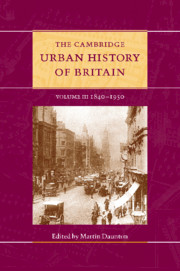Book contents
- Frontmatter
- 1 Introduction
- Part I Circulation
- Part II Governance
- Part III Construction
- 14 Patterns on the ground: urban forms, residential structure and the social construction of space
- 15 Land, property and planning
- 16 The evolution of Britain’s urban built environment
- 17 The planners and the public
- Part IV Getting and spending
- Part V Images
- Select bibliography
- Index
- Plates 1-7
- Plates 8-14
- Plates 15-20
- Plates 21-27
- Plates 28-34
- Plates 35-41
- Plates 42-48>
- Plates 49-53
- References
15 - Land, property and planning
from Part III - Construction
Published online by Cambridge University Press: 28 March 2008
- Frontmatter
- 1 Introduction
- Part I Circulation
- Part II Governance
- Part III Construction
- 14 Patterns on the ground: urban forms, residential structure and the social construction of space
- 15 Land, property and planning
- 16 The evolution of Britain’s urban built environment
- 17 The planners and the public
- Part IV Getting and spending
- Part V Images
- Select bibliography
- Index
- Plates 1-7
- Plates 8-14
- Plates 15-20
- Plates 21-27
- Plates 28-34
- Plates 35-41
- Plates 42-48>
- Plates 49-53
- References
Summary
The chapter proceeds from two beginnings, one dealing with the overall shape and form of cities, and the other with property development. These are then brought together through a study of late Victorian and Edwardian land reform, which had important implications both for control of urban development through town planning and for property relations. Conditions in the interwar period are next discussed, and the chapter concludes with a short account of the climactic period of planning during the Second World War. While this reflected new concerns of the 1930s, as well as those of the war itself, it also brought to maturity conceptions of town planning and property relations which had their origins in the nineteenth century. In turn, these conceptions helped shape the context within which modern historical research on urban form and landed estates began after the war.
URBAN GROWTH AND FORM
It is only relatively recently that more sophisticated attempts have been made to estimate the extent of urban land. Robin Best calculated from development plans that c. 1950 about 1.8m acres (729,000 ha) of England and Wales lay in ‘core’ urban settlements of over 10,000 population. Even on the widest definition, including most forms of development, urban land use accounted for only 3.6m acres (145,800 ha) or 9.7 per cent of the whole area, and the comparative figure in Scotland was 2.5 per cent. Best felt that ‘the tendency to exaggerate the sprawl of urban areas is rife, and probably reflects the inherent dislike and even fear of urbanisation which is felt by many people in this country’.
Keywords
- Type
- Chapter
- Information
- The Cambridge Urban History of Britain , pp. 467 - 494Publisher: Cambridge University PressPrint publication year: 2001
References
- 2
- Cited by



